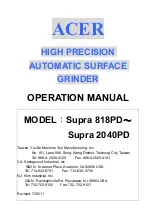
17
Turning:
■
Press the button
[2]
and turn the protective guard
[3]
so that the closed section is facing the operator.
■
Make sure that the guard is tightly fixed: The button
[2]
must engage and it must not be possible to turn
the protective guard
[3]
.
Attaching accessories (fig. II)
Warning!
Before carrying out any cleaning or
maintenance, disconnect the device
from the power supply.
Positioning the accessory
■
The support flange
[11]
has two different sides:
Place the support flange
[11]
around the spindle
in such a way that the large collar diameter for the
accessory is facing upwards.
■
Place the accessory
[10]
on the support flange
[11]
. The accessory must lay flat on the support
flange
[11]
.
Tightening the clamping nut [9]:
The clamping nut has two different sides. Screw the
clamping nut
[9]
onto the spindle
[12]
as follows:
■
When using thick (6 mm) accessories
[13]
, attach the clamping nut
[9]
onto the spindle
in such a way that the collar is facing downwards.
■
When using thin (3 mm) accessories [14]
,
attach the clamping nut
[9]
onto the spindle in such
a way that the collar is facing upwards.
■
Lock the spindle
[12]
using the Allen key
[7]
.
■
Tighten the clamping nut
[9]
by turning it clockwise
using the 2-hole-spanner
[8]
.
Releasing the clamping nut [9]:
■
Lock the spindle
[12]
using the Allen key
[7]
.
Release the clamping nut
[9]
by turning it counter-
clockwise using the 2-hole-spanner
[8]
.
Operation
Setting the speed
Using the setting wheel
[5]
the speed can be preset
and adjusted infinitely.
Positions 1 to 6 correspond approximately to the
following no-load speeds:
1
→ 1300/min
4
→ 2900/min
2
→ 1800/min
5
→ 3500/min
3
→ 2400/min
6
→ 4000/min
VTC electronics ensures appropriate processing of
materials and a nearly constant speed even under
load.
Switching on and off (fig. I)
Always guide the device with
both hands.
Switch on the device first, then
move the accessory towards the
workpiece.
The machine should not draw in additional dust.
When switching the machine on or off, keep it away
from dust deposits. After switching off the machine,
wait until the motor has come to a standstill before
you place it down.
In continuous operation, the machine continues run-
ning if it is forced out of your hands. For this reason,
always hold the machine with both hands, use the
handle provided, stand in a stable position and
concentrate.
Switching on:
■
Push the slide switch
[1]
forward. For continuous
operation, tilt it downwards until it engages.
Switching off:
■
Press the rear of the slide switch
[1]
and release.
Working instructions
Press the machine down lighty and
move across the surface to be proc-
essed.
Maintenance / Care
Warning!
Before carrying out any cleaning or
maintenance, disconnect the device
from the power supply.
During maintenance work, always use
your personal safety equipment such
as protective glasses, gloves and
breathing mask.
Clean the device regularly.
The frequency depends on the processed material
and on the duration of use.
Motor cleaning:
Blow compressed air through the rear ventilation
slots of the machine regularly and thoroughly.
Summary of Contents for KNS 150-E
Page 3: ...3...
Page 4: ...4 3 I 1 4 2 3 5 6 3 2...
Page 5: ...5 II 9 10 7 8 11 12 13 14 9 9...
Page 81: ...81 Adolf W rth GmbH Co KG GR...
Page 82: ...82...
Page 83: ...83 FI...
Page 84: ...84 P2 30 mA W rth 1 2 3 4 5 6 7 8 9 10 11 12 13 6 mm 14 3 mm W rth...
Page 137: ...137 Adolf W rth GmbH Co KG BG...
Page 138: ...138...
Page 139: ...139 FI...
Page 140: ...140 2 30 mA W rth I II 1 2 3 4 5 6 7 8 9 10 11 12 13 6 mm 14 3mm W rth...
Page 165: ...165 Adolf W rth GmbH Co KG RU...
Page 166: ...166...
Page 167: ...167...
Page 168: ...168 FI FI P2 30 A W rth I II 1 2 3 4 5 6 7 8 9 10 11 12 13 6 14 3 W rth...
















































